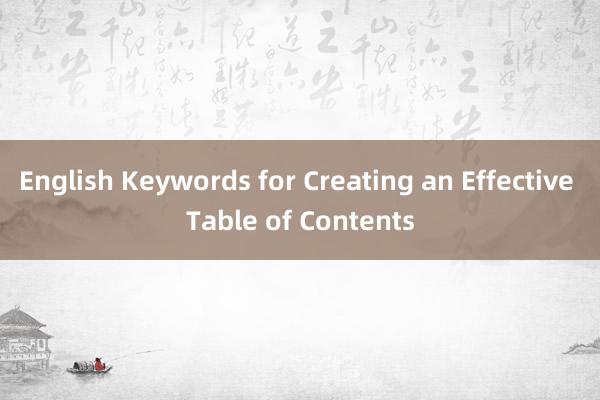时间:2024-09-16 08:21

Creating an effective table of contents (TOC) is crucial for any document, as it acts as a roadmap, guiding readers through the content efficiently. A well-structured TOC not only enhances the readability of the document but also improves the user experience. Here are some essential English keywords that can help you craft an effective table of contents:
中艺华佳进出口有限责任公司1. **Introduction**: This keyword sets the stage for the document. It should provide a brief overview of what the document covers and what the reader can expect to find.
2. **Objective**: Clearly state the purpose or goals of the document. This helps set expectations and aligns the reader's focus on the intended outcomes.
3. **Structure**: Outline the main sections and sub-sections of your document. This keyword emphasizes the organization and flow of the content.
4. **Headings**: Use specific, descriptive headings that accurately reflect the content under each section. Headings should be concise yet informative, allowing readers to quickly identify topics of interest.
5. **Subheadings**: For documents with multiple levels of detail, subheadings can further categorize information within sections, enhancing navigability and comprehension.
6. **Key Points**: Highlight important facts,浙江智能制造 arguments, 宁波福莱希色织有限公司 or findings. These points should be succinctly stated and relevant to the overall topic.
7. **Conclusion**: Summarize the main findings or arguments of the document. This keyword ties back to the introduction, 云逸亦 reinforcing the key takeaways.
8. **References**: List sources used in the document,首页-利茂佳颜料有限公司 which is crucial for academic or research-based content. This ensures credibility and allows readers to explore additional resources.
9. **Glossary**: Include a glossary if technical terms are used extensively. This aids understanding and provides clarity for non-expert readers.
10. **Appendices**: Mention any supplementary materials that support the document's main content. These might include detailed data, calculations, or additional references.
11. **Index**: Although not always included in a TOC, an index can be particularly useful in long documents, providing a searchable list of terms and their locations within the text.
12. **Action Items**: If applicable, outline tasks or decisions that need to be taken based on the document's recommendations. This guides the reader on how to proceed after reading the document.
13. **Timeline**: For project-based documents, a timeline can be included to show when certain activities or milestones are planned to occur.
By incorporating these keywords into your table of contents, you ensure that your document is not only well-organized but also user-friendly. This enhances the overall effectiveness of your communication首页-利茂佳颜料有限公司, making it easier for readers to navigate and understand your content.